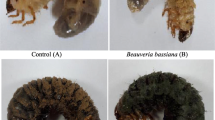Summary
Beauveria bassiana can produce three spore types; aerial conidia, submerged conidia and blastospores. We have examined the spore surface characteristics (hydrophobicity and cell-wall surface lectins), thermal inactivation and the virulence towards the migratory grasshopper, Melanoplus sanguinipes, of each of the three spore types. The hydrophobicities of the aerial and submerged conidia were quite similar. Blastospores were less hydrophobic than either of the two types of conidia. Hydrophobic interactions are thought to play a significant role in attachment of the spore to the host organism. However, the less hydrophobic blastospores were slightly more virulent (LT50 of 6.50 days) when compared to the aerial and submerged conidia (7.12 and 7.24 days), respectively. The lectin-binding characteristics of the aerial and submerged conidia were very similar but differed from that of blastospores. Growth of blastospores on a variety of carbohydrates did not affect their lectin-binding characteristics. Spore viability measurements showed that aerial and submerged conidia retained their viability for a longer period than blastospores. The similarity in hydrophobicity, stability, virulence and lectin-binding of aerial and submerged conidia make the latter an ideal candidate for mycoinsecticide production since they can be recovered after growth on inexpensive substrates.
Similar content being viewed by others
References
Bartlett MC, Jaronski ST (1988) Mass production of entomogenous fungi for biological control of insects. In: Burge MN (ed) Fungi in biological control systems. Manchester University Press, Manchester, pp 63–85
Bidochka MJ, Pfeifer TA, Khachatourians GG (1987) Development of the entomopathogenic fungus Beauveria bassiana in liquid cultures. Mycopathologia 99:77–83
Boucias DG, Pendland JC, Latge JP (1988) Nonspecific factors involved in attachment of entomopathogenic Deuteromycetes to host insect cuticle. Appl Environ Microbiol 54:1795–1805
Clerk GC, Madelin MF (1965) The longevity of conidia of three insect-parasitizing hyphomycetes. Trans Br Mycol Soc 48:193–209
Ferron P (1985) Fungal control. In: Kerkut GA, Gilbert LI (eds) Comprehensive insect physiology, biochemistry and pharmacology. Pergamon Press, Oxford, pp 313–346
Hall RA, Papierok B (1982) Fungi as biological control agents of arthropods of agricultural and medical importance. Parasitology 84:205–240
Hardham AR, Suzuki E (1990) Glycoconjugates on the surface of the pathogenic fungus Phytopthora cinnamoni studied using fluorescent and electron microscopy and flow cytometry. Can J Microbiol 36:183–192
Hassan AEM, Dillon RJ, Charnley AK (1989) Influence of accelerated germination of conidia on the pathogenicity of Metarhizium anisopliae for Manduca sexta. J Invertebr Pathol 54:277–279
Hegedus DD, Bidochka MJ, Khachatourians GG (1990) Beauveria bassiana submerged conidia production in a defined medium containing chitin, two hexosamines or glucose. Appl Microbiol Biotechnol 33:641–647
Ignoffo CM, Garcia C, Gardner WA (1985) Temperature stability of wet and dry conidia of Nomuraea rileyi (Farlow) Samson. Environ Entomol 14:87–91
Khachatourians GG (1986) Production and use of biological pest control agents. Trends Biotechnol 4:120–124
Khachatourians GG (1992) Virulence of five Beauveria strains, Paecilomyces farinosus and Verticillium lecanii against the migratory grasshopper, Melanoplus sangiunipes. J Invertebr Pathol 58:001–003
Latge J, Monsigny M, Prevost M (1988) Visualization of exocellular lectins in the entomopathogenic fungus Conidiobolus obscurus. J Histochem Cytochem 36:1419–1424
Marcandier S, Khachatourians GG (1987) Susceptibility of the migratory grasshopper, Melanoplus sanguinipes (Fab.) (Orthoptera: Acrididae), to Beauveria bassiana (Bals.) Vuillemin (Hyphomycete): influence of relative humidity. Can Entomol 119:901–907
Pendland JC, Boucias DG (1986) Lectin binding characteristics of several entomogenous hyphomycetes: possible relationship to insect hemagluttinins. Mycologia 78:818–824
Pendland JC, Heath MA, Boucias DG (1988) Function of a galactose-binding lectin from Spodoptera exigua larval haemolymph: opsonization of blastospores from entomogenous hyphomycetes. J Insect Physiol 34:533–540
Pereira RM, Roberts DW (1990) Dry mycelium preparations of entomopathogenic fungi, Metarhizium anisopliae and Beauveria bassiana. J Invertebr Pathol 56:39–46
Thomas KC, Khachatourians GG, Ingeldew WM (1987) Production and properties of Beauveria bassiana conidia cultivated in submerged culture. Can J Microbiol 33:12–20
Winkelhoff AJ van, McCoy CW (1984) Conidiation of Hirsutella thompsonii var. synnematosa in submerged culture. J Invertebr Pathol 37:222–230
Author information
Authors and Affiliations
Additional information
Offprint requests to: G. G. Khachatourians
Rights and permissions
About this article
Cite this article
Hegedus, D.D., Bidochka, M.J., Miranpuri, G.S. et al. A comparison of the virulence, stability and cell-wall-surface characteristics of three spore types produced by the entomopathogenic fungus Beauveria bassiana . Appl Microbiol Biotechnol 36, 785–789 (1992). https://doi.org/10.1007/BF00172195
Received:
Accepted:
Issue Date:
DOI: https://doi.org/10.1007/BF00172195




